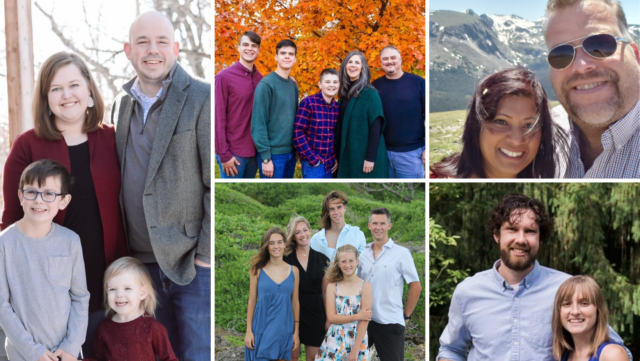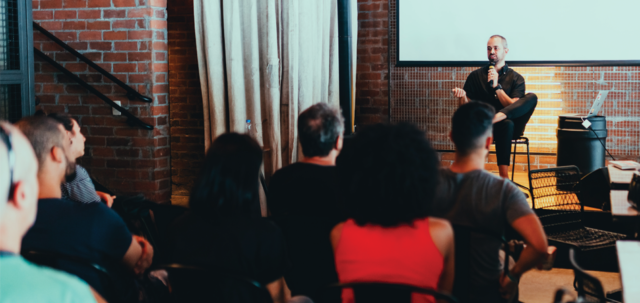– From Cutting Edge, “The Church of Jesus Is the Hope of the World,” Summer 2010
South Suburban Vineyard’s radical vision (adapted from Geno Olison)
Our mission from the beginning was to build a multicultural church. But to do that, we decided to build a multicultural team first. I thought we had a better chance if our team was visibly multicultural.
You hit the ground not knowing what will happen. We didn’t know if we’d be able to do it: to have a multicultural church. But I do know that I was not seeing it done effectively, inside or outside the Vineyard.
Our starting model is pretty different from other models. I spent the first 18 years of my life in the African American church. When I moved to Champaign, I got involved in InterVarsity…and then I met the Vineyard. Both of those groups were mostly white people. Those two drastically different experiences from my background made me upset that everyone seemed to be okay with homogeneous churches.
So I felt called to change that.
My wife and I are a biracial couple; I’m African American, and she’s white. We have a passion to see life done in a way that is open to the difficulties that multi-racial families face. A lot of people from multi-racial families are attracted to our church…they can understand all the difficulties of growing up with that background. A lot of our members come from families where that’s the case.
Our first public service was this past November. There were so many people from different cultures there. I don’t know whether this is just fleshly and selfish, but I would have been disappointed if we hadn’t had a bunch of people from different cultures there.
To start a homogeneous church and then work from there—well, we have seen other churches having a lot of difficulty turning around once there’s homogeneity. That’s why we wanted to hit the ground this way.
We picked Homewood, Illinois as the place to plant our church. It’s a straight-south suburb of Chicago. I grew up in the inner city. It was all homogeneous African American, especially church culture and friendship circles. But within the last ten years, a number of housing projects were torn down in Chicago. The downtown areas are being redeveloped into condos and that kind of thing, and a lot of people from the city have been displaced out to the suburbs.
Recently my parents purchased a place in Homewood. When my wife and I were looking at places to plant a church, we would drive through Homewood looking around at the people. “Is that a Latino—no, are they mixed?” We must have looked pretty strange to all the people around! But we just wanted to know, “Is this area truly diverse?” So we’d drive around and try to guess everyone’s ethnicities. We wanted to go to a city that was headed in the multi-ethnic direction, or one that was already there and openly proud of it. We looked at Denver; we looked at other places. It seems that people living in Homewood now have generally been happy to see more diversity. It seemed natural that we could plant there, be close to family, and that we wouldn’t be completely alienated.
My father pastors a church in the city. There was a young couple there that the Lord placed on my heart. I was trying to figure out a way to approach them to be on our planting team. Finally I decided to talk to my dad and ask him if it was okay. It turned out the man in this couple was already interested in our vision, so my dad released them to start coming to our small group meetings. It took them three or four months to feel like God had given them the green light to officially join us.
I look at the whole process…it was like an onion being peeled back slowly. God brought our whole team together, but it took a long time. I had to be patient. A while before we planted, I was sitting in Happy Leman’s office, and he said to me, “What makes you think you can do this?”
I told him, “We get to start from scratch. We have a blank slate. God sent us the resources—the opportunity.” I knew we could mess up, but God was providing the start for us.
I’ve gone to church-planting boot camps for the last five years. Sometimes they sit you down and tell you the worst horror stories. You brace yourself for a crazy pace where you can only kiss your wife once a week! But then what happened was, we found that there was actually a change of pace for the better. We had a fantastic team. We asked them to commit for two years, and that means everybody pulls their own weight. Everyone responded to the challenge beautifully. And it was all way more fun than we expected it to be.
We hit the ground in June of last year, which gave everyone time to settle into the area. There are still struggles; not everyone loves their jobs. I work part-time and watch my son during the day, but I also get to meet with new people from church, have lunches, connect people.
We had our first membership class two weeks ago. We’ve just finished our 20th week of services. Around 50 people attend each week. The newspaper called us this week. God is working. Some of the challenges are on the multicultural front—especially worship. Most of our leaders come from a rock background. And we don’t want to have strictly gospel music, either. We’re going for a crossover, and that requires a higher level of expectation. We’re working on our craft, trying to simplify. We want to have a good fusion. I’m discipling the worship leader right now. We’re getting there, but we’re not there yet.
One personal struggle for me happened after our first service. 86 people showed up for our first service on November first. It was a lot of family, a lot of friends who were supporting what we were doing. The second week, there were 29 people. It was a very deflating weekend. It felt weird and empty after the first weekend. It was the hardest sermon for me to preach, just with that amount of people there.
But the interesting thing was, there were two brand new families there that second weekend. One was an interracial couple (Mexican and Hawaiian). So one of these couples had a boy who played with a neighbor kid. When they went to pick their boy up one day, the other couple asked them if they wanted to come to a Vineyard service with them. So both of these families came to our church. They were the only people there who were not a part of our church-planting team! But for whatever reason, they all stayed. I have no idea why. I don’t know why they came back. I wouldn’t have come back if I’d heard my sermon! But they did. They had come from a huge megachurch, but they stuck with us. They became good friends with us. All of them serve faithfully every Sunday. They help with sound, and kids, and just everything we do.
We put a bunch of invitation flyers up at Jewel’s. Every time I’d go back in there, a bunch of the flyers would be missing. I always thought that someone was taking them down and throwing them away.
But then one day, a man and his family came to the Vineyard. He told us, “I saw this flyer at Jewel’s, and I’ve been holding onto it for five or six weeks now.” He’d been listening to my sermons online and finally decided to visit. He has three kids, and he’s also a former pro wrestler! But wrestling has a lot of history for him that he wants to distance himself from now—it was too much of his identity. Having him is great. We have to tell him to go home after church! He keeps staying and helping with things.
I would also have a pig roast every week. It would gather maybe 75 people from the neighborhood. One woman started coming to our Vineyard through that pig roast. She was absolutely loving that roast! She started coming off and on to small group. I am just delighted when I think of all the stories of people finding us in unusual ways.
I think we’re seeing our vision happen. People are drawn to us; you see one or more faces that actually look like you. You’re not the only one of your ethnicity there. We didn’t want that. People won’t give your church a second visit if they feel uncomfortable. If people don’t know how to press through or break through their discomfort and work through the external barriers, they’ll give up. We want to communicate at our church that we value diversity in leadership and in decision making. We want to remove as many barriers to the gospel as possible.





